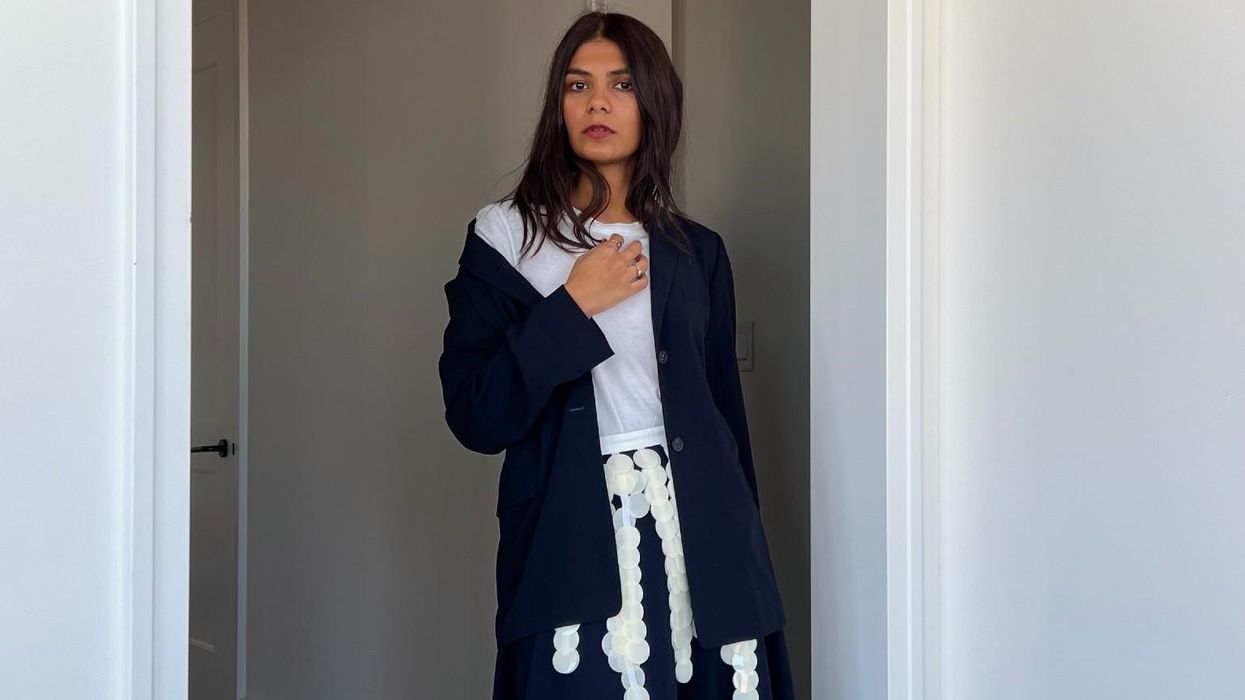Suits That Don't Feel (Or Look) Like Suits
How one writer used modern styling to counteract their corporate essence.

A few years ago, I had a corporate job with a very strict dress code: wear a suit, or go home. When I left that job, I made a solemn vow neither to work at another place where I was only allowed to wear morose suits, nor to ever wear a suit again. Recently, however, (having recovered from the bitterness of my hapless corporate stint) I’ve found myself gravitating towards two-piece suits. This attraction has been, in part, due to a suit’s ability to convey a kind of put-togetherness, a polished exterior self that can betray the wearer’s circus of a mind, as well as the ease with which it solves the conundrum of what to wear.
Upon being offered one of my first "adult" jobs in my early 20s, replete with health insurance and a 401K, I headed straight to Banana Republic to purchase my interpretation of "adult" office-wear: a black jacket with stiff peaked shoulders reaching for the corporate stratosphere, narrow lapels, and a single button that nipped in at the waist and black bootcut trousers. We were only allowed to wear black suits with white shirts. So every third day I wore a white and blue striped button-down, my tiny act of resistance against starched whites. After my last day at that job my worn-on-repeat suits were banished to the furthest region of my closet.
"Pantsuit Nation" politics, #girlboss aesthetics, and exclusionism masquerading as feminism further intensified my aversion to suits. Those ideas tended to make the suit feel like a performative emblem of something that often seemed patriarchy adjacent. As suiting flowed in and out of fashion's lexicon, it was one trend I could not brave a dalliance with. Around this time, I acquired my first Prada piece, a second-hand jacket from the Fall 2004 collection. It seemed to me so mature that I was immediately uncertain. Some time later, I found the matching skirt to complete the suit, and once again it felt so adult that I held on to it, but waited.
This past year, firmly cemented in my 30s, I sought to challenge the parameters of my personal style, determined to emerge from the cocoon the pandemic had ushered me into (and in which I'd grown too comfortable). After shying away from them for so long, I was drawn to the structure and assuredness of a suit, and of its implications beyond the workplace. Sure, it's a quick and easy outfit that comes together in a mere minute, but it was the cheekiness of wearing a suit to a leisurely lunch or to run errands or to a party in a way that rejected the traditional understanding of it—with imposing shoes, a cornucopia of jewelry, an old and worn soft t-shirt or no shirt at all—that made the suit all that much more alluring to me.
A suit can be loaded with sensuality. By wearing a suit outside the context of the workplace is to reject its norms—where it should be worn, how it should be worn, what it conveys about its wearer—and transforms the conventional into something very chic. No one has recontextualized the suit quite like Miuccia Prada, whose collections from the late '80s till today have frequently examined and interrogated this two-piece garment beyond its anticipated traditional setting. At both Miu Miu and Prada, the storied designer has played at making the suit more democratic, and certainly more tongue-in-cheek: kicky skirts, high slits, in sickly sweet shades and psychedelic space-age prints, like Jackie O on acid. Or suits so severe, brimming with the suggestion of a kink, as exemplified in Prada's Fall 1994 collection of buttoned-up black skirt suits in silhouettes hinting at a by-gone era of austerity and excess. One can almost envision Shalom Harlow marching down the runway in her military boots with a riding crop in hand. Below, I've documented three methods of reimagining a suit that feel nothing like the corporate monotony of my twenties.
Photo: Courtesy of Tasnim Ahmed
Taking a page straight out of the Prada playbook, instead of trying to soften this rather strict black skirt suit with a pair of heels or a more sensual boot, I like to throw off the balance by wearing boots that are chunky and sturdy and aren't overtly feminine—boots that would produce a stomp, if you will. To make it a bit more casual, I wear it with an old white t-shirt, but I would also strongly recommend wearing something like this with a dinosaur t-shirt a la Michelle Pfeiffer in One Fine Day. Think "Central Park Conservatory Board member at Glastonbury."

Photos: Courtesy of Tasnim Ahmed

I must confess that I'm partial to skirt suits for the sole purpose of not having to wear pants. While I'm still not prepared to tackle a rainbow-hued assortment of pant suits, I'm fully committed to an all-black look in unexpected tailoring, such as an exaggerated wide leg with a jacket in an unusual cut (vintage Thierry Mugler and Yves Saint Laurent jackets are the best at achieving this). Shirt optional.

Photo: Courtesy of Tasnim Ahmed
There's more room for play with a suit in cooler weather, but this is my favorite suit to wear as soon as the temperature starts climbing up from the mid-50s. It's a secondhand Jil Sander set, and at first I considered having it altered to fit me better, but then decided I liked it as it was, oversized, like a child playing in grown-up clothing. I like to wear it with a visually and aurally loud belt by Sara Lanzi—it's the perfect flirtation with spring and a kiss goodbye to summer in belt form. To round out this recipe, the weirder the shoe, the better.




